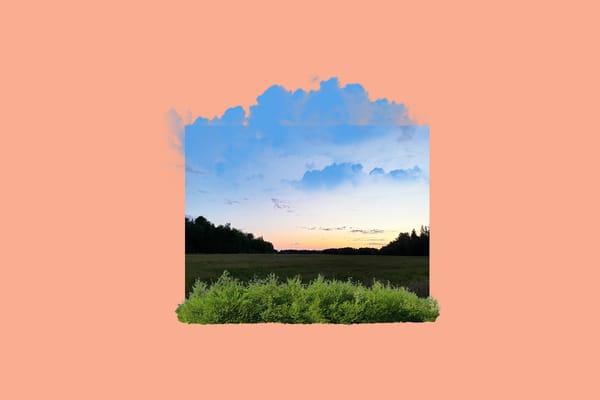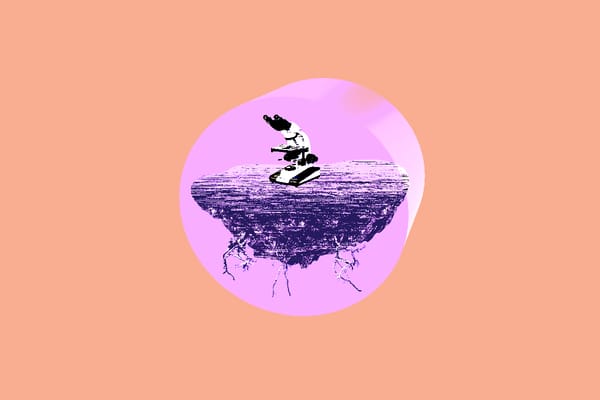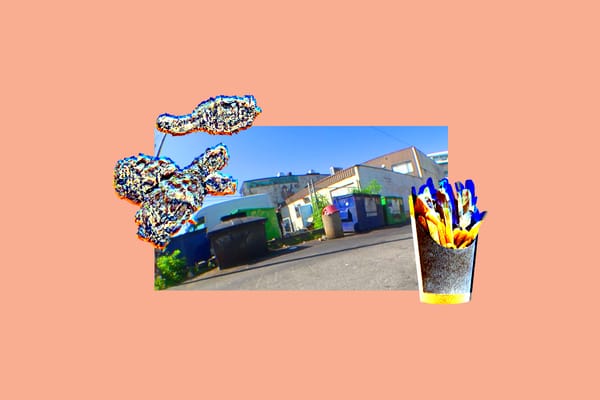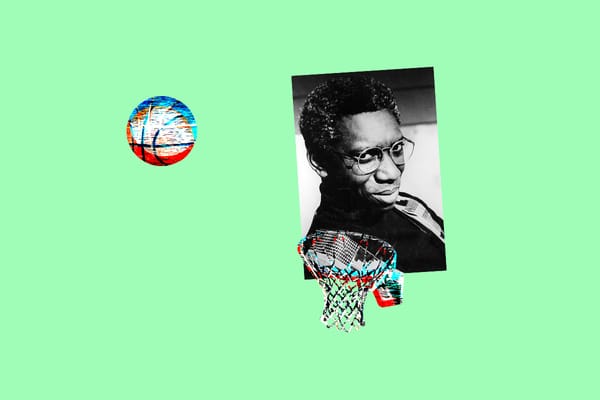Channelling your energy
Why are more professional skateboarders turning to YouTube?

A deep blue Philadelphia 76ers hat cuts across a pale blue sky as professional skateboarder Tom Asta centres himself in frame. His right arm extended, the lens of the camera in his hand pointed back in his direction — selfie style. Asta, a former protégé of two-time Thrasher Skater of The Year Chris Cole, has been a reputable PRO since 2011. In that time, he’s travelled the world, graced the cover of magazines, released a nearly double-digit number of video parts, and had signature model shoes, boards, and any other skateboarding-adjacent product you can conceivably squeeze a name onto. Which is to say, he’s done almost everything there is for a professional skateboarder to do.
And now, he’s standing on the perimeter of his local outdoor skatepark, talking into his camera to an audience that isn’t present but will be soon.
“What’s cracking everybody? I made it back from L.A. Thank you all for tapping into that video, man. The Primitive video is doing super well on my channel, and I just want to thank you guys. I hope you guys enjoyed it.”
That message of gratitude is a part of the introduction to a video on Asta’s personal YouTube channel titled “MY ELITE BUSHING SETUP!” The video “doing super well” is the one he’d uploaded previous to this one, “PRIMITIVE PARK with KELLY HART, P-ROD, PJ LADD & SPANISH MIKE!” As of writing this, it’s the third-most viewed offering on his channel and his most ambitious to date. In it, Asta, as you might expect, travels to Los Angeles, California, and skates at the Primitive Skateboards skatepark with Kelly Hart, Paul Rodriguez, PJ Ladd, and Spanish Mike.
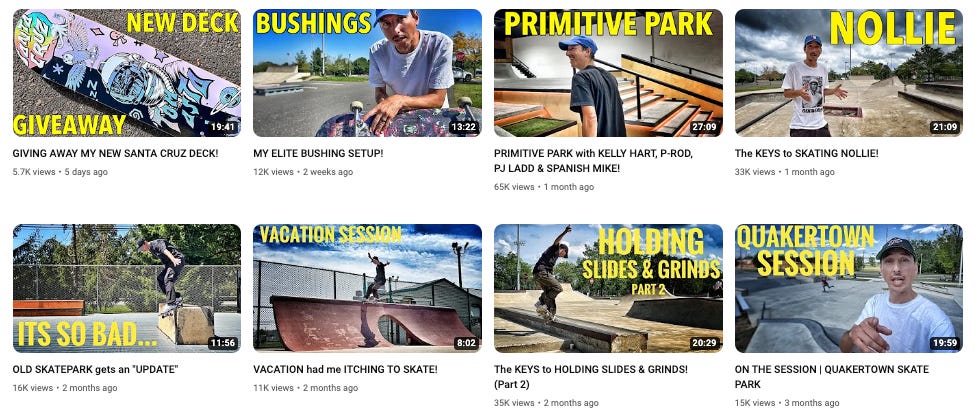
It’s also a crossover episode of sorts. Like Asta, Rodriguez has also started putting significant time and effort into building his personal YouTube channel, which I’ve written about before.
While it wouldn’t be entirely accurate to say that Paul Rodriguez has suddenly become a YouTuber, there has been a recent and marked shift in his style of YouTube content that now more resembles what could be considered classic YouTuber fare. From vlog series like “Life Reset” to unboxing videos and even a number of 20+ minute affairs where P-Rod breaks down his current board setup — that’s quintessential YouTuber, nay, SkateTuber content.
It’s been an interesting evolution for this avenue of his online output, which he initially launched around 12 years ago, with the first entry in “Paul Rodriguez’s Official YouTube Channel” being a 24-second clip of baby Paul bailing and then landing a switch frontside flip down an eight stair. Hundreds of small park edits, check-ins, compilations, and other miscellany would follow in the intervening years. But it wasn’t until May, 2023 that P-Rod seemed to take this new direction for his channel more seriously, even releasing a “Welcome to my YouTube!” video that, well, welcomed the uninitiated to his YouTube, which currently boasts over 300k subscribers.
Considering Rodriguez’s reach, for Asta to essentially cross-promote with him was a big get for his burgeoning channel of just over 30k subscribers. He’d get candid about the moment in “MY ELITE BUSHING SETUP!”
“It was definitely a cool experience to film around those dudes. I was definitely a little bit out of my comfort zone. If I seemed a little bit awkward at times, it’s because I was. [I’ve] never filmed a YouTube video in L.A. Never filmed a YouTube video around those people. So it was cool, and they were all super supportive… they wanted to be in the video and [were] happy to do it.”
By speaking to his audience in this way, as if they’re friends and just catching up, Asta, whether intentionally or not, is employing a standard YouTuber technique. One that, if successful, works to create a more intimate relationship between himself and his viewers. If you’ve ever watched content from a YouTube influencer, you’ll recognize the parlance, emotive style, and casual openness. That’s because establishing a relationship with the audience is how creators build community and maintain continued engagement, and if they monetize their channels, money. It can also result in what is often wantonly diagnosed online as “parasocial relationships.” Writer Megan Farokhmanesh broke the concept down for The Verge in 2018.
Sociologists Richard Wohl and Donald Horton originally coined the concept of parasocial interactions and relationships in 1956 to explain how audiences developed attachments to media figures. It boils down to one-sided affection: a person invests emotional energy and attachment in a media figure, and they develop a sense of kinship and intimacy that makes them feel as though they know the celebrity — even though the celebrity has no idea they even exist.
Modern researchers have expanded upon Wohl and Horton’s original findings to better understand online celebrities. “Since 1956 when it was first talked about, we’ve gotten so many new technologies... [that] really change how we are entertained and how we engage with content,” Arienne Ferchaud, an assistant professor in the School of Communication at Florida State University, tells The Verge. Ferchaud co-authored a paper last year — “Parasocial attributes and YouTube personalities: Exploring content trends across the most subscribed YouTube channels” — with an eye toward the most popular influencers.
Previous celebrities existed behind the one-way gate of television, but today, audiences can chime in on social media with questions, requests for future content, and opinions on what a creator produces. “In that way, the audience actually has an active role in the content that is created,” says Ferchaud. “It sort of blurs the line between creator and viewer [in a way] that hasn’t been possible before.”
That blurring of lines is something that “traditional” skateboarding YouTubers — popular online creators who’re not professional skateboarders themselves — like John Hill and Ben Degros have long traded in. Degros would acknowledge as much in his “retirement” video, saying that he didn’t want to step away from his skateboarding YouTube channel without letting his fans know because he’s aware of the relationship that he’s built with them and wanted to show them respect by saying goodbye (while also teasing that he may not actually be done making skateboarding-related YouTube videos — another classic YouTuber engagement strategy).
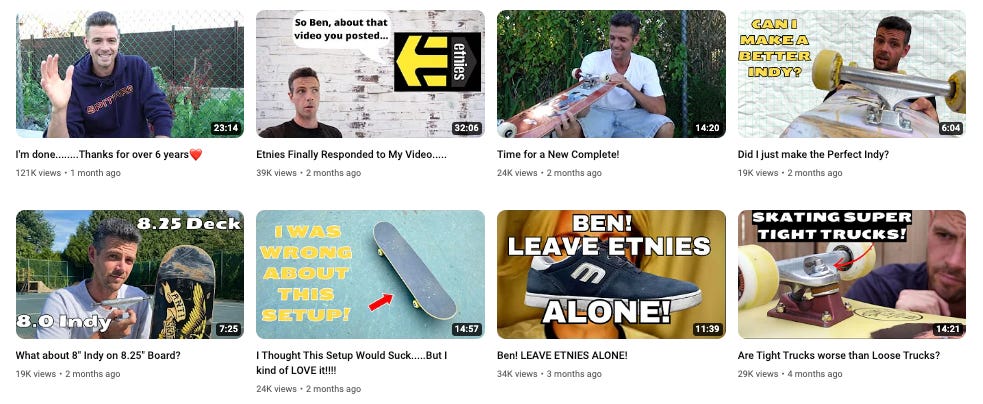
While one-sided fan relationships are not new for globally recognized professional athletes, it is still unusual to see Asta and Rodriquez attempt to capitalize on them further by leveraging their existing notoriety to become “personalities” on YouTube. And they’re not the only ones. 2023 has seen skateboarders like Pedro Delfino and Felipe Gustavo follow suit to varying degrees of success and consistency. The Nine Club podcast host Chris Roberts has also started to pay more attention to his personal channel, which is branded “I’m Glad I’m Not Me” and features Roberts in vlog-style outings as he does everything from announcing skateboarding contests to going… indoor skydiving.
But those are just the skateboarders taking a more “traditionalist” bent to their YouTube strategy. Others have a much simpler approach. In October alone, Dylan Jaeb, Wade DesArmo, and Ishod Wair uploaded full video parts to their respective YouTube channels. For DesArmo and Wair, those were the only videos they had ever uploaded — no vlogs, unboxing vids, park edits, or anything of the sort. Instead, all three used their channels like bespoke media houses, fulfilling the role that a Thrasher would generally take. While that’s not unusual in the macro sense — who hasn’t uploaded a video part to YouTube — for top PROs to do it is certainly new.
So why are more PRO and AM skateboarders turning to the ‘Tube? What’s the benefit of using a platform whose most popular users are often stuck with the stigma of being “YouTubers?” I talked to Jorge Angel, Vice President of Excel Management, the firm that manages the careers of skaters like Wair, Rodriguez, Gustavo, Nora Vasconcellos, Mark Gonzalez, and more, about the potential career advantages ‘Tubin’ can offer their clients.
Angel surmises that for someone like Jaeb (a former Excel client), he simply prefers having more say over his output and, ultimately, his career. He’s also from one of the first generations of skateboarders weened on social media. Jaeb even came to prominence as a viral Instagram skater known for his staggering levels of “content creation,” telling Thrasher, “I used to post crazy—I posted every single day for two years straight when I was a kid.”
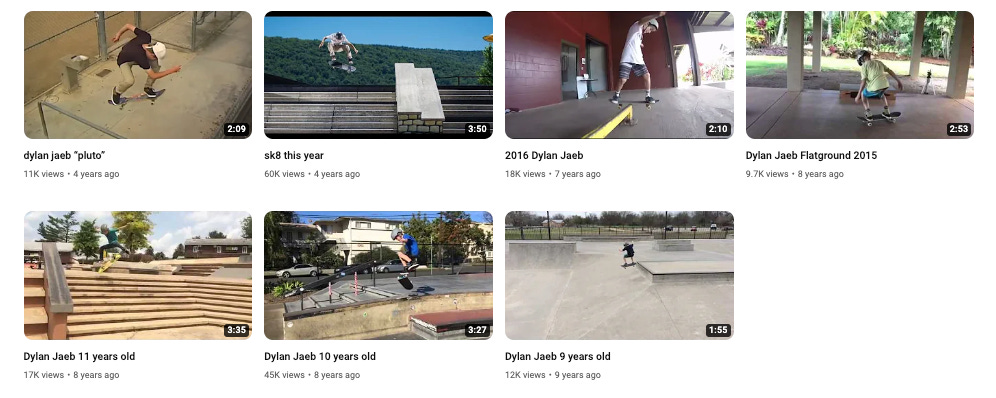
That high-intensity posting contributes to a level of personal brand development and control that exists far outside what professional skateboarding had previously known, when hard-copy videos and magazines used to be the main source of exposure for aspiring skateboarders. Since childhood, Jaeb has worked to build his audience on social media, which now sits at over 300k followers on Instagram across two accounts and 13k on YouTube. He seemed to recognize the worth of those followings early on, bouncing between board and shoe sponsors before finally landing with ones that fit, presumably making those decisions on his terms, as well. So, it makes sense that he’d release a video part on his YouTube channel out of the blue; Angel says, “It's just best for him to do it on his own.”
For Wair, his Chronological video part — comprised of all the footage he logged while on a trip for Mason Silva’s Thrasher Skater of The Year tour video in 2021 — was more of an experiment, says Angel. “He was just sitting on that footage and [had been] toying with the idea of having a YouTube channel [and thought] it'd be ‘pretty cool if I drop this random footage I have that no one's ever going to do anything with.’”
Releasing it himself on YouTube is also a path of little resistance. “[With] Thrasher or someone else, it takes a lot of time because of [securing] music rights and things like that. If [Ishod] does it on his own, he can just put it out. So it gives skaters the freedom of not having to wait on anyone.”
What success will look like for Jaeb and Wair on YouTube is not entirely clear, nor if those typical measures like “traffic” and “engagement” even matter to them. But for the skaters who take a more conventional approach to their channels, like Asta and P-Rod, Angel says that sponsors are starting to see the value in it, with some even adding budgets for YouTube content into their sponsee’s contracts. Of course, “value” means content that performs well and gets their riders and their products into the eyeballs of as many viewers as possible.
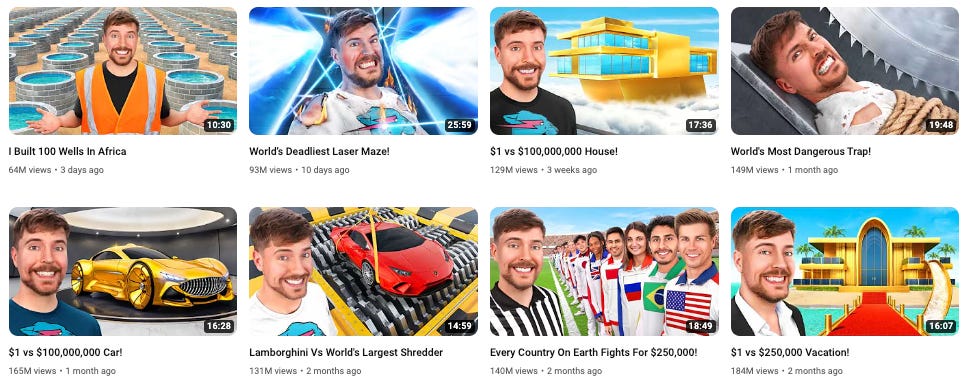
That’s also the basic nuts and bolts of how YouTube creators make money from the platform itself. Once a channel reaches “1,000 subscribers and either 4K valid public watch hours in the last 12 months OR 10M valid public Shorts views in the last 90 days,” its owner can apply for the YouTube Partner Program. If accepted, they can begin monetizing their accounts, getting a small share of the revenue from the ads that play on their videos and the ability to engage “fan funding.” For P-Rod, whose channel is already quite large, he splits his share of the ad revenue with Spanish Mike, who films and edits his videos.
But P-Rod is a special case, given he’s already one of the most professionally and financially successful skateboarders of all time. YouTube seems more like a lark for him than a way to pay rent. With Asta, he has to produce his content himself, which can be a significant amount of work for what can amount to little or no pay while your channel is in its infant stages (the workload-to-pay ratio is part of the reason SkateTuber stalwart Ben Degros hung it up, and he has over 100k subscribers). If someone of Asta’s respectable but still mid-tier career stature was able to get his sponsors to subsidize the creation of his videos, which could then (theoretically) make him additional money via YouTube ad revenue sharing, that seems like a decent way to supplement his income while still being able to do the primary job of a professional skateboarder: brand promotion.
Paradoxically, that has become easier and infinitely more demanding in the last decade. As skateboarding’s traditional media ecosystem shrunk as digital offed print, Thrasher became a media monolith, and content sites like The Berrics lost credibility with the industry’s premier names, it left many career skaters in a lurch. Where would they get coverage now? If you weren’t a Thrasher-ass skater, could you get the exposure required to promote the brands that paid you to do so? Enter social media, which became not so much a solution but the suffocating end result of the issue it helped create.
Now, skateboarders are encouraged to build their personal brands and followings online in service of attracting sponsors who want to use those audiences they’ve cultivated to promote their products. Professional and amateur skaters have become both their own media outlets and influencers, posting and sharing to gain followers, boost engagement, and meet their contractual obligations. However, growing and maintaining an Instagram or YouTube account is mostly unpaid labour that may never come back around as profit. Because, as is their nature, for a social media account to flourish, you must always be tending to it. Creating content, becoming content. And what does one get from that in the end? Maybe some free gear, a roster spot on a team and a decent (by meagre industry standards) monthly cheque, and, if you’re lucky, some budget to create even more content. Ultimately, skateboarders will sink untold hours into filming, editing, and posting with the hope that this “content” — themselves — “does well” online.
YouTube is just as extractive as any other social platform. Its advantage is that after you spend all of that time and energy commodifying yourself, becoming yet another venue for advertisements to be broadcast, you may get a sliver of the money the tech-behemoth whose platform you’re using is making off of you, which is more than nothing, to be sure. Sometimes a lot more — if you’re willing to put all of yourself into it. An internecine scheme to keep the dream alive. This increasingly hazy notion of a professional skateboarding career that demands more and more of a person but gives back less and less. A fever dream of what once was shattered by an earnest voice calling out from the present.
“What’s cracking everybody?”


